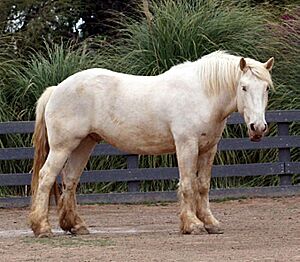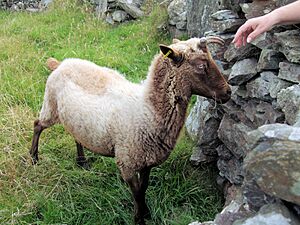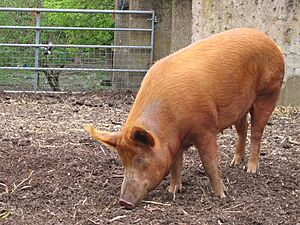Rare breed facts for kids
A rare breed is a type of animal, like a chicken or a cow, that has very few of its kind left in the world. This means their numbers are quite small, usually from a few hundred to a few thousand.
Because there are so few of them, rare breeds might be in danger of disappearing forever. Many countries have groups that work hard to protect these special animals. For plants, the idea is similar; they are called heirloom plants.

Contents
What Makes a Breed "Rare"?

A "breed" is a group of animals that share similar looks and traits. For example, all Pinto horses have spotted coats. A stricter way to define a breed is that their babies will always look and act like their parents. This is because their traits are passed down through their genes.
Groups that protect animals have their own ways of deciding if a breed is rare. The Rare Breeds Survival Trust (RBST) in the UK and The Livestock Conservancy (TLC) in the US both sort rare breeds into five groups. The "critical" group is the rarest of all.
For TLC, a livestock breed is "critical" if fewer than 200 new animals are registered each year in the United States. Also, its total number worldwide must be less than 2,000. The RBST looks at how many breeding females are in the United Kingdom. For horses and sheep, fewer than 300 females means they are "critical." For goats and pigs, it's fewer than 100 females.
The The Poultry Club of Great Britain says a chicken breed is "Rare" if it doesn't have its own special club. These "Rare Breeds" are looked after by the Rare Poultry Society. The British Rabbit Council also lists rabbit breeds that are considered rare.
Why Do Breeds Become Rare?
Many things can cause animal breeds to become rare. Sometimes, farmers start using new types of animals from other countries. These new breeds might grow faster or produce more milk, so farmers choose them instead. This means the older, traditional breeds are used less and less.
Also, if a breed doesn't make much money for farmers, it might be forgotten. Diseases can also reduce the numbers of a breed. Changes in how farms work or losing land for animals to live on can also make breeds rare. For example, after World War II in Britain, new pig and sheep breeds were brought in. Farmers thought these were more profitable, so older British breeds became less common.
Protecting Rare Breeds

Many groups work to protect rare livestock and poultry breeds. These include the Food and Agriculture Organization of the United Nations, The Livestock Conservancy, and Rare Breeds Survival Trust. They want to save these animals because they have special traits. These traits can help keep our planet's biodiversity strong. They also help preserve our cultural heritage.
Keeping different types of animals is important for farming. It helps animals adapt to tough places or new challenges. These challenges could be new diseases, changes in the weather, or different market needs.
There are two main ways to protect rare breeds:
- On-farm protection: This means keeping the animals on farms, ranches, or with herders, just like they normally live.
- Off-farm protection: This involves keeping animals in places like zoos or special conservation farms. Sometimes, even genetic material, like semen or embryos, is saved in special freezers.
In 2009, The Livestock Conservancy started an online service to help people find rare breeds. It lets people look for rare livestock and poultry to buy. They can also find products like meat or wool from these special animals. This helps make sure rare breeds have a future.
Other Reasons to Keep Rare Breeds
Besides conservation, people have other reasons for keeping rare animals. Some hobby farmers enjoy them because they often need less intense care. Tourist places might keep rare breeds to attract visitors. Some farmers also like to sell meat from rare breeds. They believe these breeds offer better quality food.
See also
- Ark of Taste
- Cobthorn Trust
- Conservation Priority Breeds of the Livestock Conservancy
- Heritage turkey
- Landrace
- Rare breed (dog)

